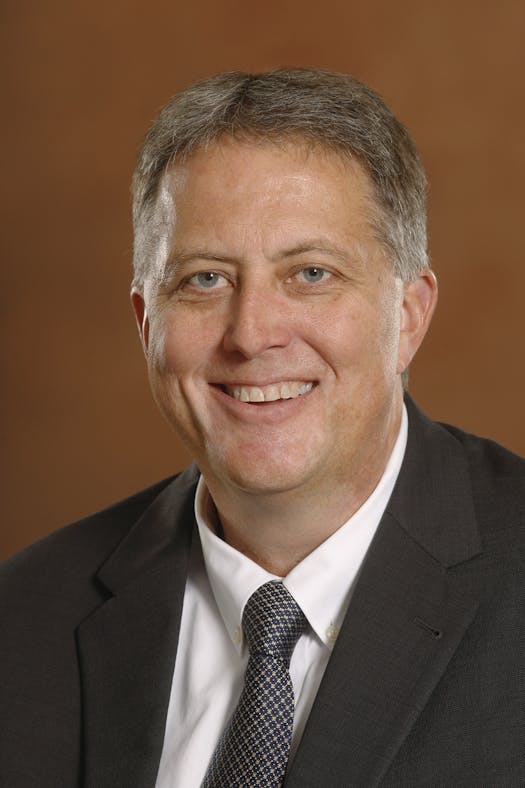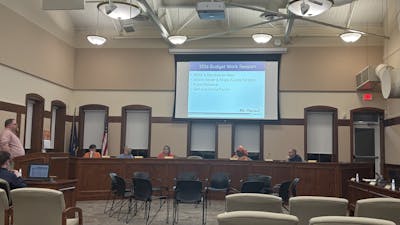'Right on the money'
How CMU determines and balances its Operating Budget

The Voice of The Chippewas, Adam Jaksa, left, and CMU sidelines reporter Kristina Fusco, right, host the award ceremony during the Maroon and Gold Gala, at McGuirk Arena, Monday, April 28, 2025. Over 400 student-athletes showed up for the event. (CM-Life | Mark Hoover)
Each year, many of the offices and groups within Central Michigan University meet to create a new budget for the upcoming academic year. There are many considerations that go into this process.
Joe Garrison is the executive director for the financial planning and budgets office, and is one of those in charge of planning CMU's operating budgets.
“(The financial planning and budgets office is) the hub for all budget development,” he said. “Our office works directly with all units across campus.”
Beginning in late December and ending in June, Garrison and a number of offices and people work together to draft and approve the upcoming year’s budget on a yearly basis.
Garrison said the timeline for this process typically looks like this:
- Late December: budget development begins
- February - March: financial planning process
- May - June: The State of Michigan will announce how much colleges can receive from the state, since there’s a better indication of how many new students will be enrolling in the fall.
- June: Board of Trustees votes and approves the budget
In the early spring, Garrison said his office will meet with other offices to start developing a budget and go through the financial planning process. He said there are a number of factors considered during this process including:
- State funding
- Student enrollment
- Tuition rates
The amount of money the state can give to the college varies year by year, Garrison said. Funding varies depending on the expected inflation, where the state of Michigan decides to allocate its money and Michigan’s “tuition restraint,” or the decided cap of how much public universities are allowed to charge their students.

Central Michigan Budget Officer/Assistant to the University President for Strategic Initiatives, Joe Garrison, poses for a portrait. (Courtesy of Joe Garrison)
“If you think about it, (state funding) could be flat, increase, or in some years, it could be a decrease,” Garrison said. “We need to know what (the state’s) assumption is so we can work with that within our budget.”
According to the 2024-25 Operating Budget, CMU had a revenue of around $442 million. The top two sources of revenue include:
- Tuition, room and board at around $270 million
- State appropriations at $98 million
Garrison said student enrollment is another big consideration. His office meets with the Office of Academic Planning and Analysis to discuss the upcoming year’s enrollment projection, which factors in the projected enrollment rate, retention rate and enrollment goals.
These projections will also include enrollment within different departments. These projections can decide whether departments need more or less funding, based on the department’s enrollment.
Garrison and his team will take enrollment projections given to them and model budgets around potential tuition rates.
“Part of what our office does is ... model (the enrollment projections) out based on different tuition rates and then we have discussions with the executive budget committee and with the board of trustees to see what they may be willing to approve as far as tuition rate increases, if they’re needed,” Garrison said.
The role of academic planning
Robert Roe, the executive director of Academic Planning and Analysis, said his office works on creating student credit hour predictions that it sends to Garrison.
“We're very focused on student success, and we do a lot of work with the frontline people, the faculty, the advisors, all the people that are working directly with students,” Roe said. “We don't work directly with students, but we provide information that would hopefully be helpful in predicting student success.”
Roe said his department starts the work of getting the student credit hour predictions in mid-November to December.
The first step, he said, is to consult with the department of Student Recruitment and Retention. This way, they receive information about the number of new students and use historical data to predict the number of returning students.
Then, Roe said his office is able to see how many credits on average students take and apply that number to the headcount.
In January, Academic Planning and Analysis works with the college deans and department chairs to gather information on the programs and courses offered, and accounts for any changes, Roe said.
By February, they share their predictions with Garrison.
Roe said three staff members from his office work on this project. But, he said, Academic Planning and Analysis does other things on campus, such analyzing of the impact of programs like Leadership Safari and gathering student exit surveys.
“We support student success in many different ways,” Roe said. “We look at factors that are predictive of students returning. ... We evaluate programs and different approaches to student learning and determine whether they have a positive impact on student outcomes.”
On the college level
Garrison explained that enrollment numbers matter not only for the university at large, but for the eight colleges on campus as well. Roe meets with the deans to discuss preliminary enrollment numbers, retention rates and course section demand and availability.
One of these deans is Christopher Moberg, who oversees the College of Business Administration (CBA). In Fall 2024, the college had a budget of about $43 million to work with. Of those funds, the college only spent around $19.6 million. Moberg said the remaining $23 million was invested back into the university at large.
In general, Moberg said the budgeting process for his college is pretty straightforward, especially with constant monitoring and planning. He said the hardest parts are the fluctuating numbers and the uncertainty that comes with them.

Central Michigan Dean for the College of Business Administration, Christopher Moberg, poses for a portrait. (Courtesy of Chris Moberg)
“You never know for sure,” he said. “You’re trying to project sales, or a budget that you don’t know yet. We’re already in the start of our fiscal year in July-August before we know if we’re over or under or right on the money. … The most challenging part is the lack of control for what happens. You can do your best to estimate, but things can happen, which is why you have to closely monitor it.”
Moberg said there are two major areas the funds go toward: Paying salary and benefits out to faculty and staff, and supplies and services that benefit students and the college operations.
This reflects in the 2024-25 operating budget, which shows that 97% of the CBA budget went toward salary and benefits for faculty and staff. The remaining 3% - a little over half a million dollars - goes towards various programs and events for student success.
“Some of these are (paid for) by our generous alumni, but sometimes we make the decision to pull out of our own budget,” he said.
Moberg said CBA prioritizes creating positive experiences for students on and off campus and providing them with career development opportunities.
For example, he said the college’s Office of Student Engagement and Professional Development (affectionately called “The HUB”) helps students network and prepare for their careers after college.
For off-campus career development, Moberg said the college strives to send students to the “3 C’s”: competitions, conferences and corporate visits. He used the Queller Leadership Scholars as an example, who recently attended a business conference in Atlanta, Georgia.
“At the end of the day, when you look at our spending, it’s all about supporting our faculty and students,” he said.






